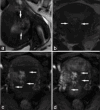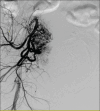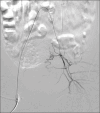Uterine Arteriovenous Malformations
- PMID: 39310860
- PMCID: PMC11414961
- DOI: 10.4103/jmu.jmu_103_22
Uterine Arteriovenous Malformations
Abstract
Uterine arteriovenous malformations (AVMs) are an abnormal presence of shunts between myometrial arteries and veins within the myometrium that usually occurs after a traumatic event on the uterus and it is often diagnosed after a miscarriage. In this case report, we propone the case of a woman, gravida 3 para 2, admitted at the emergency department presenting deep vaginal bleeding and suspicion of incomplete miscarriage at 11 weeks of pregnancy. The suspect of AVM was made with noninvasive procedure; transvaginal ultrasound examination with the advantage of color Doppler showed a myometrial hypervascular lesion of the posterior wall. Pulsed Doppler permitted the waveform analysis of uterine arteries and three-dimensional sonography with color Doppler and reconstructions clearly showed dilated ad tortuous blood vessels within the contest of the myometrium. Magnetic resonance angiography showed multiple tubular structures with tortuous appearance that confirmed the suspicion of AVM. Uterine artery embolization was performed of the right uterine artery. One month after uterine embolization, the ultrasound control confirmed the complete resolution of the AVM.
Keywords: Embolization; magnetic resonance; ultrasound; uterine arteriovenous malformation; vaginal bleeding.
Copyright: © 2023 Journal of Medical Ultrasound.
Conflict of interest statement
There are no conflicts of interest.
Figures













References
-
- Diwan RV, Brennan JN, Selim MA, McGrew TL, Rashad FA, Rustia MU, et al. Sonographic diagnosis of arteriovenous malformation of the uterus and pelvis. J Clin Ultrasound. 1983;11:295–8. - PubMed
-
- Vogelzang RL, Nemcek AA, Jr, Skrtic Z, Gorrell J, Lurain JR. Uterine arteriovenous malformations: Primary treatment with therapeutic embolization. J Vasc Interv Radiol. 1991;2:517–22. - PubMed
-
- Timor-Tritsch IE, Haynes MC, Monteagudo A, Khatib N, Kovács S. Ultrasound diagnosis and management of acquired uterine enhanced myometrial vascularity/arteriovenous malformations. Am J Obstet Gynecol. 2016;214:731.e1–731.e10. - PubMed
-
- Polat P, Suma S, Kantarcý M, Alper F, Levent A. Color Doppler US in the evaluation of uterine vascular abnormalities. Radiographics. 2002;22:47–53. - PubMed
Publication types
LinkOut - more resources
Full Text Sources
